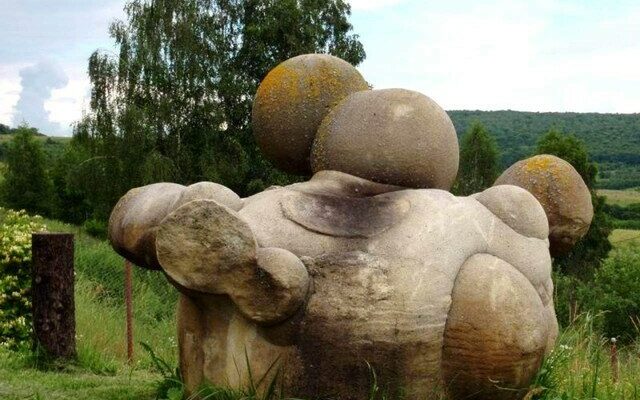In Romania, there is an area of strange rocks, called trovants, that have the ability to expand and grow like mushrooms after being exposed to rain water. Rocks are inanimate objects. They are not living creatures.
They have no biological processes, cannot breathe, reproduce or move. At least, this is something we all know.
However, there is a special stone in Romania that is completely an exception, they have the same “behavior” as a living organism. During the dry season, Trovant is completely immobile and stays in place without changing size. But when the rainy season comes, the stones seem to come to life, start to increase in size and even move.

The researchers suspect these unusually spherical rocks were formed by the unusually intense and prolonged seismic activity of the Middle Miocene. The shock waves generated by large earthquakes compacted sand deposits and condensed limestone cement into spherical lumps – commonly known as trovants.
What causes these rocks to grow, move and multiply?
Trovants come in a wide variety of sizes and shapes, with some being able to fit in the palm of your hand while many are taller than a person’s head, even reaching 4.5 meters in size. Of the more than 100 trovants recorded at at least 20 sites, some of the rocks were excavated after the sand surrounding them was quarried.

The strange rocks in Romania that have the ability to swell and grow like mushrooms after rain is a mysterious phenomenon that attracts a lot of attention from the scientific community. These rocks are related to a geological phenomenon in the area.
Trovant is made up of a core of hard rock and sand or gravel that forms around it. These unique structures can only form in highly porous sand deposits and sandstone deposits bound by calcium carbonate-rich water.
Calcium carbonate is required in trovant formation, and it also plays an important role in making rocks grow in the presence of rainwater. After each heavy shower, trovant species absorb the minerals of the rainwater, then naturally combine with chemicals already present in the rock, creating a reaction and internal pressure. This pressure causes the rock to grow from its center to its edge and multiply, with a deposition rate of about 4-5 cm over 1000 years.

In fact, some trovants are fixed to the ground below through solid rock, like the “Old Ladies” block in Ulmet. Their unusually bulging shape comes from ancient origins. This stone was found in the Romanian village of Costesti.
The word trovant means “cement sand”. This rock is formed from a type of sand that appeared millions of years ago on Earth. In fact, the earthquakes that created this strange rock happened 6 million years ago.
Trovant occurs in a smooth and non-angular shape, usually cylindrical, nodular or spherical. Trovants develop these inconsistent shapes as they “grow” and “proliferate” due to the irregular secretion of “cement”. You can see these stones grow from only a few millimeters in size and to as large as 10 meters.

But it’s not just their structure and ability to grow, but their proliferation that makes trovant rocks unique. They can also move from place to place. And if that’s not enough, they also have root-like extensions and age rings that can be seen when you cut the rock. However, until now, scientists have not been able to explain these unique features.
The amazing thing is that during and after each rain, Trovants rocks in the village of Costesti grow like mushrooms. The stones just kept growing, growing strangely. Trovant only grows when there is rain. Normally they are only 6 to 9 mm in size, but when water enters they swell up to 6 to 10 meters. Some rocks even know how to move. Cut the stone in half and see that there are rings of veins inside like a tree trunk.
Visually, since trovant rocks are clearly a combination of the characteristics of a plant and a rock, it is unclear whether they should be classified as living organisms. But whether they are alive or not, these growing stones provide a majestic sight – a must-see when visiting Romania’s Valcea District.

Inside trovants are hard rock cores, outside is a crust made of sand. However, the swelling phenomenon of trovants is explained by some scientists as a high mineral content beneath the rock’s crust. When the rock surface is wet, this mineral begins to pressurize the outer sand layer and cause the rock mass to begin to swell.
Various small cubes: oval or rough like acne spots appear on the faces of the stones. This is a form of concreting with grains of sedimentary sand or rock bound together by calcium carbonate. “Some are made from sandstone, others from gravel. In geological terms, they can be called grindstones and agglomerates,” said Florin Stoican, representative of Buila-Vanturarita National Park.

There is little research on the origin of the “growing stones” in Romania, but many theories have been put forward. According to the International Geological Congress in Oslo 2008, “Trovant” is considered a type of “sandstone concrete”. According to the hypothesis put forward at the congress, the Romanian Trovant has a magnetic texture that reflects the paleodynamic conditions (early seismic) and corresponds to the specific composition of the sand sediments (especially carbonates). accumulates in the sand, occurs during significant seismic tremors.

Source: link



